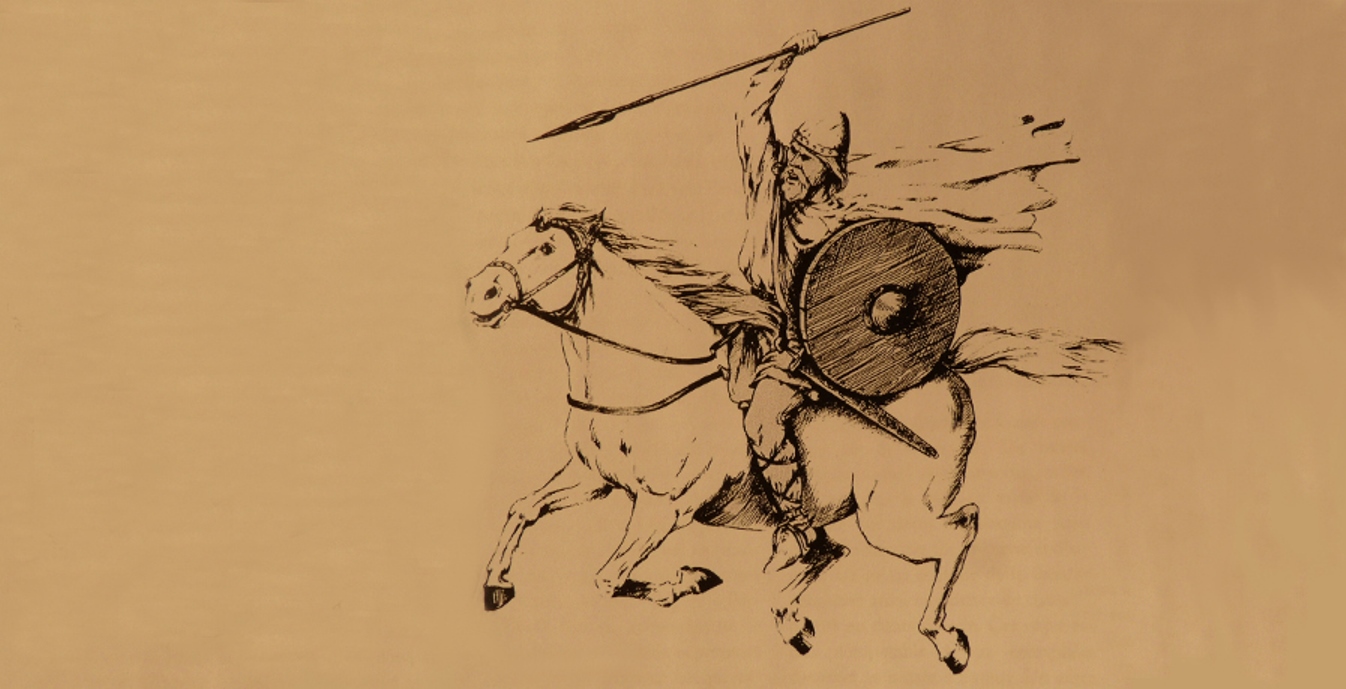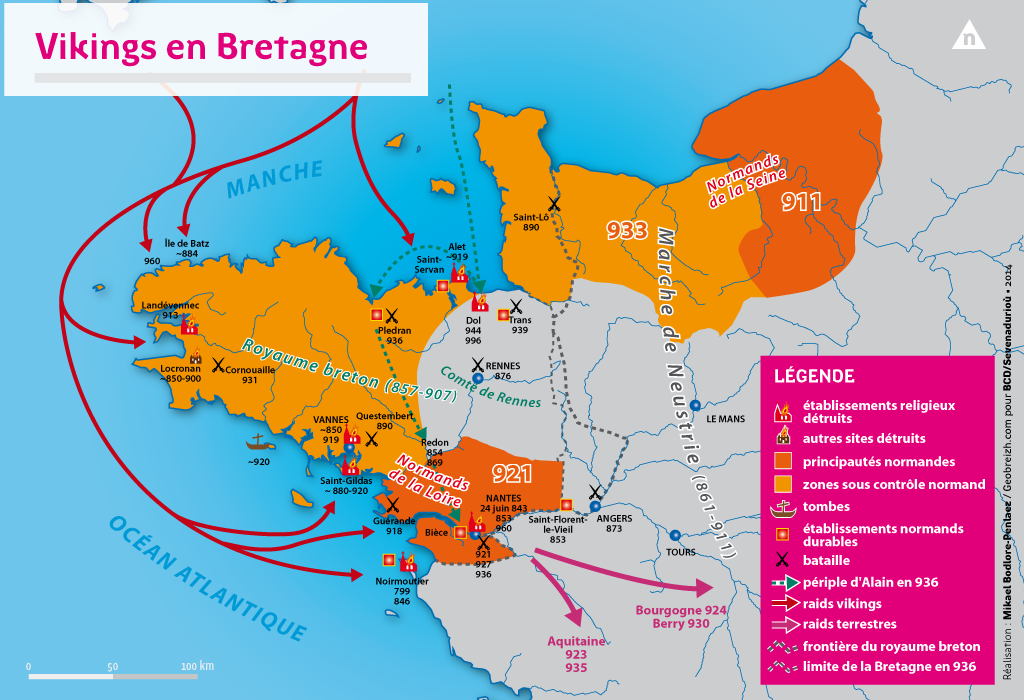On 24th June 843, the feast day of St John the Baptist, a fleet of Viking ships from Norway made their way up the river Loire and took control of the city of Nantes by surprise. The city was ransacked, its bishop was killed inside the cathedral, and its citizens were either murdered or captured and sold as slaves. It was the start of a century-long feud between the Bretons and the Vikings, which would leave the region decimated. The Breton kings kept the Vikings at bay, despite frequent attacks, but in spite of their efforts, in 853 the Vikings established a settlement on Bièce, an island on the Loire, overlooking Nantes. They would stay there for almost three quarters of a century. They built a fortified settlement on the island, which doubled as a permanent marketplace where they sold goods pillaged during raids. During the 880s, by taking advantage of the political turmoil of the civil war, they even took control of a large part of Brittany’s lands, before being ousted by Alan the Great.
Exodus of the Elite
In 913, Alan’s successor Gourmaëlon died, leaving Brittany without a legitimate ruler. The region became a choice destination for Norse raiders. The land was an obvious target for expanding their territory, since the rest of north-western Europe was already either under Viking rule, or very well protected by powerful princes.
In 911, under the Treaty of Saint-Clair sur Epte, King Charles III of West Frankia ceded Rouen and the lower Seine valley, later the heart of modern-day Normandy, to the Viking warlord, Rollo.
In 913, the Vikings also attacked and raided the monastery at Landévennec, which at the time was the biggest monastic establishment in western Brittany. This had a deep impact on Breton religious power. From then on, successive raids were met without even the smallest resistance and continued to devastate the region. In 919, Ragenold (Rögnvaldr) dealt the final blow to the former kingdom by launching an attack on the mainland, and settling in Nantes, from where it seems he ruled the whole of Brittany.
Starting in 913,
members of the church and aristocracy had begun to leave Brittany in huge numbers, heading for Frankia or England. Ragenold’s invasion gave this wave of migration an increased sense of urgency and the majority of the remaining members of the ecclesiastical and aristocratic classes left the region between 919 and 920. They took so many of Brittany’s religious relics and manuscripts with them that not a single text written by Breton monastic scribes from the period before the arrival of the Vikings exists today in Brittany. In some places, and in particular the area around Nantes, the human exodus was massive. The Chronique de Nantes (Chronical of Nantes), written the following century, explains that “only the poor Breton farmers who cultivated the land were left to face these barbaric oppressors, without help or support.” However, Juhel Berengar, the Count of Rennes, managed to keep his lands and stay put throughout this period, thanks to a handy talent for switching sides between the Franks and the Normans.
Norse Chiefdoms in Brittany
After an unsuccessful five-month siege of Nantes, Robert, Marquess of Neustria, who would
become King of Frankia the following year, conceded “Brittany, which they had devastated, including the region of Nantes” to Ragenold, according to the chronicler Flodoard. And so, from 921 a Viking chiefdom existed in Brittany, and was recognised as such by the Franks.
Apart from Nantes, there is evidence of the presence of several other small Norse chiefdoms in Brittany, for example in Cornouaille, and also likely in the area of Penthièvre. Jean-Christophe Cassard also mentions other probable Viking settlements on the northern coast of Brittany: St Malo, where the Solidor Tower of Saint Servan suggests their presence; Saint Suliac; Trans (the Vieux M’na settlement); and especially the Péran settlement at Plédran.
The 920s therefore mainly stand out as the beginning of the Viking’s colonisation of the mainland. However, unlike the Seine Vikings, who chose to adopt the Frank’s administrative and financial proceedings, those of the Loire mainly kept to an essentially military presence, exploiting the land without trying to organise it.
Far from being satisfied by the Treaty of 921, Ragenold continued attacking the Franks, with Nantes serving as his support base. In 923 he attacked the Aquitaine and Auvergne regions, and continued up the Loire in 924 to raid the region of Burgundy. This led the Franks to once again lay siege to Nantes in 927, but they remained unsuccessful. Nantes was confirmed as Viking territory – but this time the rest of Brittany was not mentioned – in exchange for an end to the Viking raids. This didn’t stop the Norsemen breaking the Treaty again in 930, when they attacked the Aquitaine and Limousin regions. This time however, they experienced a severe defeat on the Dordogne at the hands of Frankish King Raoul.
931 saw the first Breton rebellion, led by a young Alan ‘Wrybeard’, who would become the first Duke of Brittany, and Berengar, Count of Rennes, and it seemed the winds were changing. In Cornouaille, the Bretons massacred the Norse occupants, starting with the chief, Duke Felecan. With the element of surprise no longer on their side, the Nantes Vikings, commanded by Incon, Ragenold’s successor, launched a huge retaliation operation on Brittany, with the help of William Longsword, ruler of Normandy, and Alan Wrybeard was once more forced into exile. However, he returned to reclaim his throne in 936, and this time he faced a Viking army weakened by a succession of defeats on the Loire, and abandoned by their fellow raiders. However, the last Vikings were not defeated until 939.
An Irreversible Hiatus
What is there to show for more than 20 years of Viking rule in Brittany? Overall, there is nothing in the social or economic organisation of communities after 939 that dates back to Viking rule. This does not in any way mean that the years 913 to 936 were simply a hiatus without consequences. The Vikings may not have organised themselves politically, but they did have the time to build settlements. Several place names of Norse origin have survived in Brittany, especially along the coast. The discovery of a Viking ship burial at Groix in 1906 points to their desire to be remembered as official and willing settlers. And the few genetic details we have access to even allow Jean-Christophe Cassard to suggest that there was greater Viking colonisation in Brittany than in Normandy.
Any way one looks at it, the Viking interlude was an irreversible hiatus in Brittany’s history. Its largest ecclesiastical communities made their way back to the area
as soon as they could, but empty-handed. The memory of Brittany had been annihilated. Overall, the history of its first few centuries of existence can only be re-written, so to speak, according to texts from Gallo-Roman and Frankish chroniclers – adversaries of the Breton kingdoms – from Gregory of Tours, to Ermold the Black. Ruined and deprived of its cultural riches and its spiritual heritage, Brittany had been liberated, but had lost the spirit which had so defined the Kingdom of Nominoe and his successors.




